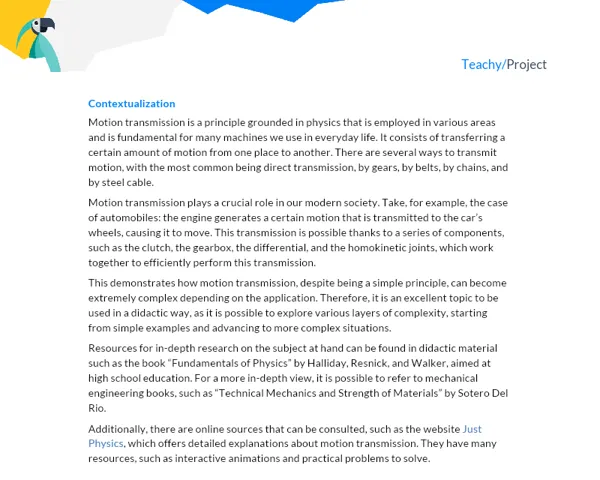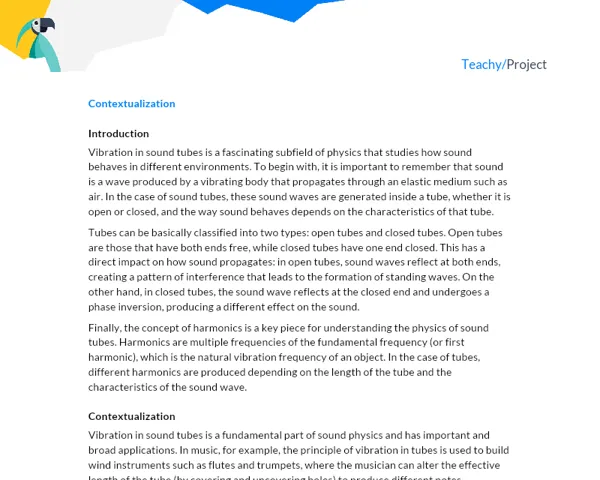Contextualization
Physics is a science that helps us understand the world around us. It is full of concepts and formulas that help us understand how the universe works. One of these formulas, which is at the core of geometric optics, is the Gauss Equation for lenses, also known as the Lens formula.
The Gauss equation is a formula that allows us to calculate the position and size of an image formed by a lens. It is represented by the formula 1/f = 1/di + 1/do, where "f" represents the focal length of the lens, "di" the image distance, and "do" the object distance. In this project, our goal is to understand how this equation works in practice and how to apply it to predict the behavior of light as it passes through a lens.
These concepts are fundamental to the understanding of physics and have direct applications in our daily lives. Lenses are present in our lives in numerous ways, whether in the glasses that correct our visual impairments, in the cameras that allow us to capture moments, or even in microscopes and telescopes that allow us to explore the universe on different scales.
Importance
Understanding how lenses work and the Gauss equation can help us better understand various technologies we currently use. From this understanding, we can improve our problem-solving skills, think more critically, and develop a sharper perception of the world.
In fields such as optical engineering, medical physics, and photography, understanding the Gauss equation is essential to staying up-to-date and innovating. Furthermore, in a society increasingly based on technology, understanding these basic physics concepts can open doors to various careers and life possibilities.
Practical Activity: "Exploring the Gauss Equation in Practice"
Project Objective
The objective of this project is to apply the theoretical knowledge of the Gauss Equation for lenses in practice, thus understanding, in a more concrete way, this important concept of physics. Additionally, it aims to enhance teamwork skills, communication, time management, and critical thinking.
Detailed Project Description
Students must form groups of 3 to 5 members and create an experiment in which they will use the Gauss Equation to predict the position and size of the images formed by different lenses.
It is important that students plan and execute the experiment together, recording all observations and measurements, analyzing and interpreting the results in light of the Gauss Equation, and finally reporting all these steps in a detailed report.
Required Materials
The following materials will be needed to carry out the experiment:
- Set of lenses with different focal lengths (can be found in laboratory product stores)
- Ruler or tape measure
- Support for the lenses
- Lamp or flashlight
- Millimeter paper
- Pencil and eraser
- Camera or smartphone with a camera
Experiment Step by Step
- Choose one of the lenses and note its focal length (usually this information comes on the packaging or manual of the lens set).
- Position the lens in the support and place the lamp or flashlight at a fixed distance "do" from the lens.
- Using the Gauss Equation, calculate the distance "di" that the image formed by the lens should have.
- Place the millimeter paper behind the lens, at the calculated distance "di", and mark the position of the formed image.
- Take a photo of the experiment setup for the report.
- Repeat steps 1 to 5 for the other lenses in the set.
- Analyze the results obtained and compare them with what was predicted by the Gauss Equation.
Project Deliverables and Report Structure
At the end of the project, each group must submit a detailed report containing:
- Introduction: The student must contextualize the theme, its relevance and application in the real world, as well as the objective of this project.
- Development: The student must explain the Gauss Equation, the description and methodology of the experiment, present and discuss the results obtained. The photos taken during the execution of the experiment should be included in this section.
- Conclusion: The student must conclude the work by summarizing its main points, explaining the learnings obtained, and drawing conclusions about the project.
- Bibliography: The student must indicate the sources they relied on to work on the project such as books, web pages, videos, etc.
Remember: The report should be clear, objective, and formal. Avoid the use of the first person and ensure that the language used is appropriate for the school context.



